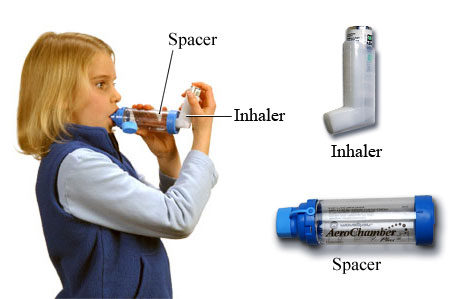Each time you use an inhaler, follow these steps:
1. Take off the cap and hold the inhaler upright.
2. Shake the inhaler.
3. Tilt your head back slightly and breathe out slowly.
4. Hold the inhaler about 2 inches in front of your mouth. Don’t place the inhaler in your mouth.
5. At the same time, press down the inhaler and begin to breathe in slowly.
6. Continue to breathe in slowly for up to 5 seconds. It’s important to inhale slowly and evenly, not sharply.
7. Hold your breath for 10 seconds. This lets the medicine travel deep into your lungs.

8. Repeat with another puff, if prescribed. If you wait a minute or two between puffs, the medication may do a better job of reaching your lungs.
9. If you are inhaling two medications at once, it’s best to inhale a quick reliever first, followed by a long-term controller.
Common Inhaler Mistakes
The above steps sound easy to do. But if you’ve tried it, you know that using an inhaler takes practice. People often make several mistakes. The major one is failing to breathe in and press down the inhaler at exactly the same time. Another problem is inhaling too fast. You also might forget to hold your breath long enough (up to 10 seconds) after inhaling the medicine. These mistakes can cause excess medicine to end up on your tongue, in the back of your throat, or just out in the air. You may cough, get a bad taste in your mouth, or, with corticosteroids, run an increased risk of developing oral infections.
Spacers
One solution to these problems is to use a spacer. A spacer is a holding device, shaped a bit like a big straw that fits between the inhaler and your mouth. Spacers make inhaling asthma medicine easier. You close your lips tightly around a spacer and slowly breathe in as you press down the inhaler. You don’t have to time everything perfectly because the spacer “holds” the medication until you inhale. It does the timing for you. If you sometimes end up coughing or gagging when you use an inhaler, a spacer can help.
There are different types of spacers. Ask your health care provider to explain how spacers work and suggest one to try. As with any inhaler, be sure to practice using an inhaler with a spacer while you’re still in your doctor’s office.
How Much Medicine Do You Have Left?
One tricky thing about inhalers can be figuring out how many “puffs” remain in the canister after you’ve used it a while. There is no perfect way to do this. Of course, if the canister is new, it’s full, and the product label will tell you how many puffs of medicine it contains. You might try keeping track of how many times you use a new inhaler. You also can check (very roughly) your inhaler by placing it (not the mouthpiece!) in a cup of water. If the inhaler sinks to the bottom of the cup, it’s full. If it bobs up and down, with the bottom end above the water, it’s about half-full. Last, if the inhaler floats sideways in the water, resting on top, it’s empty. Keep in mind, however, that this water test gives only a rough idea of how much medication you have left.
Cleaning Your Inhaler
It’s important to keep your inhaler, mouthpiece, and spacer clean. Every day, you should rinse the inhaler and spacer with warm water and place them on a towel to dry. Twice a week, wash the plastic mouthpiece with warm water and a mild dishwashing soap. Let it air dry, too.
New-and-Improved Inhalers
People with asthma have been using MDIs for more than 40 years. During that time, the inhalers haven’t changed much. But they are changing now. The drug companies that make inhalers are improving them.
Some of the changes are minor, such as remaking the mouthpiece to better fit your mouth, for example. Other changes are major. One new computerized device attaches to many inhalers and records the amount of medicine they contain. It also releases medication after you have begun inhaling, so you don’t have to time things perfectly. In fact, several inhalers offer this kind of “breath-actuated” timing mechanism.